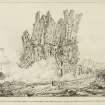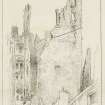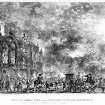Great Fire of Edinburgh
Date 15 November 1824 - 17 November 1824
Event ID 997427
Category Building History
Type Destruction
Permalink http://canmore.org.uk/event/997427
Fire broke out about 10 o’clock on the night of Monday 15th November 1824 in a second floor workshop in Old Assembly Close, belonging to the engraver, James Kirkwood (fl.1792-1804), whose specialisms included the engraving of maps (see below) and banknotes and the manufacture of globes. This was later attributed to the burning of a pot of linseed oil used in the preparation of copper plates.
Fire engines arrived promptly, but there was delay in setting them to work, and by 11 o’clock the fire had spread to the upper six storeys of the tenement.
The fire then spread across the narrow close to two tenements on the west side of the close. Owing to its narrowness, the engines were unable to play on the fire, which engulfed the building, and then spread to the adjoining Courant newspaper office. The fire then spread to destroy much of the Old Fish Market Close and Assembly Close. Embers began to rain down on the Tron Kirk.
About 5 o’clock on the morning of the 16th, the upper part of the façade of the Courant collapsed into the street.
Other buildings damaged included Abraham Thomson’s bookbindery, which had just been rebuilt following an earlier fire, the king’s old Stationery Warehouse on the west side of Old Assembly Close, the Old Assembly Hall, then occupied as a warehouse by Bell and Bradfute, booksellers. ‘These back tenements formed one of the most massive … piles of building in the ancient city, and in former times were inhabited by persons of the greatest distinction’. ‘A great part of the southern land fell to the ground; but a lofty and insulated pile of side wall, broken in the centre, rested in its fall, so as to form one-half of an immense pointed arch, and remained for several days in this inclined position’.
By 9 o’clock on Tuesday morning the fire had abated, but by 12 o’clock the steeple of the Tron (about 100 yards east of the fire) was found to be ablaze, melting the lead on the roof, and causing the bell to fall. However, the main part of the building was saved by an engine belonging to the Board of Ordnance, and the fire put out.
At 10 o’clock that night a fire broke out in the attic of an eleven-storey tenement on Parliament Square. As this was to windward of the main fire, this lead to speculation that ‘some desperate incendiary had resolved to destroy the city’.
All efforts were directed to saving the Parliament House and Law Courts. The Lord Advocate, Sir William Rae of St Catherine’s, is reported to have taken a turn working on the engines fighting the fire in a tenement at the head of Old Assembly Close, where he himself had been born.
Despite sleet and hail on Wednesday morning, the fire continued, spread by blowing embers to Conn’s Close, but there it stopped.
Damage:
High Street: four tenements of six storeys facing the Street, with their underground storeys.
Conn’s Close: two timber-fronted lands ‘of great antiquity’
Old Assembly Close: four houses of seven storeys
Borthwick’s Close: six ‘great tenements’
Old Fish Market Close: four tenements of six storeys
Parliament Square: four double tenements of seven to eleven storeys, including the shop of the caricaturist, Kay.
More than 300/400 homes were destroyed, and 13 people killed.
On Thursday the ruins were inspected by the authorities. The height of the ruins posed an obvious threat, and it was proposed to batter one eleven-storey ruin with cannon. The task of demolition was delegated to Captain Francis Head of the Royal Engineers. Captain Hope of HMS Brisk, then in Leith Roads, also offered assistance. Forty of his seamen threw a line over the southern gable above Heron’s Court, but brought down only a small portion. The next day Hope returned with iron cables, chains and ropes, while sappers undermined the wall. The mines were blown, and the gable brought down ‘almost perpendicularly’.













